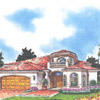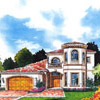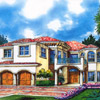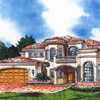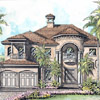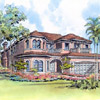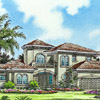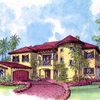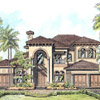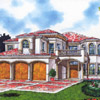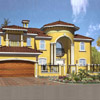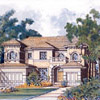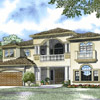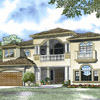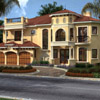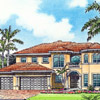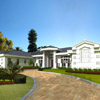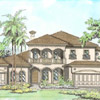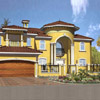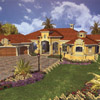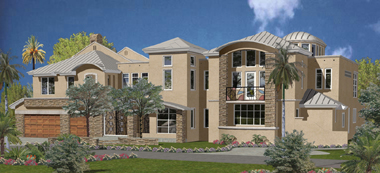The creditors' committee for Hollywood home builder Tousa is taking aim at another group of defendants in their so-far successful lawsuits stemming from claims that a bail out and refinancing in mid-2007 of a joint venture in Transeastern Properties resulted in fraudulent transfers.
The committee already won judgment against secured lenders on claims that loans made six months before the Chapter 11 filing were fraudulent transfers. The bankruptcy judge required the lenders to post a total of $700 million in appeal bonds to stay enforcement of his October ruling that the transactions were voidable in bankruptcy.
The committee, in papers filed last week, wants authority from the bankruptcy court to sue another group of defendants to recover an additional $60 million in payments made during the Transeastern bailout.
The committee, if permitted, will sue for $50 million from Arthur and Edward Falcone, who were owners of the company that was Tousa's joint venturer in buying Transeastern in 2005. The committee says money given the Falcones and their companies in mid-2007 were fraudulent transfers.
The committee also wants the right to sue Kendall Land Development LLP, which also received payments as part of the settlement in mid-2007 regarding Transeastern.
Tousa filed for bankruptcy reorganization in January 2008. The company listed assets of $2.1 billion against debt totaling $2 billion. At the outset of the reorganization it was 67 percent-owned by Technical Olympic SA.
Tuesday, December 29, 2009
Tuesday, December 22, 2009
Exterior Remodeling Proves Best Bang for Your Buck, Realtors(R) Report
Despite a slow market and a slight decrease in the resale value of most remodeling projects, Realtors® report that the smartest home improvement investments may also be some of the least expensive. Results from the "2009 Remodeling Cost vs. Value Report" show that small-scale exterior projects are the most profitable at resale, according to estimates by Realtors® who completed a recent survey.
On a national level, eight out of the top 10 projects in terms of costs recouped were exterior replacement projects that cost less than $14,000. Certain types of door and siding replacements, as well as wood deck additions all returned more than 80 percent of project costs upon resale. A steel entry door replacement -- a new addition to this year's list -- recouped 128.9 percent of costs, followed by upscale fiber-cement sliding replacements at 83.6 percent. Wood deck additions recouped 80.6 percent of costs.
"Once again, this year's 'Remodeling Cost vs. Value Report' highlights the importance of a home's first impression," said NAR President Vicki Cox Golder, owner of Vicki L. Cox & Associates in Tucson, Ariz. "With exterior projects returning a high percent of project costs upon resale, Realtors® can help give your home curb appeal while adding value to the real estate transaction."
The "2009 Remodeling Cost vs. Value Report" compares construction costs with resale values for 33 midrange and upscale remodeling projects comprising additions, remodels and replacements in 80 markets across the country. Data are grouped in nine U.S. regions, following the divisions established by the U.S. Census Bureau. This is the 12th consecutive year that the report, which is produced by Hanley Wood, LLC, was completed in cooperation with REALTOR® Magazine, as Realtors® provided their insight into local markets and buyer home preferences within those markets.
On a national level, the project with the biggest improvement from 2008 was the attic bedroom addition, recouping 83.1 percent of remodeling costs compared to 73.8 percent in 2008. The only other interior project that landed in the top 10 was a minor kitchen remodel with 78.3 percent costs recouped.
Other exterior projects in the top 10 include midrange vinyl and upscale foam-backed vinyl sliding replacements, which returned more than 79 percent of costs. In addition, several types of window replacements -- midrange wood, midrange vinyl, and upscale vinyl -- all returned more than 76 percent of costs upon sale.
Similar to last year's report, the least profitable remodeling projects in terms of resale value were home office remodels and sunroom additions, returning only 48.1 percent and 50.7 percent of project costs.
Regionally, cities in the Pacific states of Alaska, California, Hawaii, Oregon and Washington once again outperformed the rest of the nation in terms of remodeling costs recouped upon resale. The West South Central region of Arkansas, Louisiana, Oklahoma, and Texas; the East South Central region of Alabama, Kentucky, Mississippi and Tennessee; and the South Atlantic region of the District of Columbia, Florida, Georgia, Maryland, North Carolina, South Carolina, Virginia and West Virginia also performed relatively well.
The regions that generally returned the lowest percentage of costs were New England (Connecticut, Massachusetts, Maine, New Hampshire, Rhode Island and Vermont), East North Central (Illinois, Indiana, Michigan, Ohio and Wisconsin), West North Central (Iowa, Kansas, Minnesota, Missouri, Nebraska, North Dakota and South Dakota), and the Middle Atlantic (New York and Pennsylvania).
Golder commented that remodeling projects are just one of many factors that contribute to a home's overall resale value. "As the first, best source for real estate information, Realtors® are experts in providing insight into what projects and investments will make a difference in your house. It's important to consult with a Realtor® who can explain the variety of factors that affect a home's value, such as location, condition of surrounding properties and the regional economic climate," she said.
Results of the report are summarized in the January issue of REALTOR® Magazine. To read the full project descriptions, access national and regional project data, and download a free PDF containing data for any of the 80 cities covered by the report, visit www.costvsvalue.com. "Cost vs. Value" is a registered trademark of Hanley Wood, LLC.
Hanley Wood, LLC, is the premier media company serving housing and construction. Through four operating divisions, the company produces award-winning magazines and Web sites, marquee trade shows and events, rich data, and custom marketing solutions. The company also is North America's leading provider of home plans. Founded in 1976, Hanley Wood is a $240 million company owned by JPMorgan Partners, LLC, a private equity affiliate of JPMorgan Chase & Co.
The National Association of Realtors®, "The Voice for Real Estate," is America's largest trade association, representing 1.2 million members involved in all aspects of the residential and commercial real estate industries.
Information about NAR is available at www.realtor.org. This and other news releases are posted in the News Media section. Statistical data, charts and surveys also may be found by clicking on Research.
REALTOR® is a registered collective membership mark which may be used only by real estate professionals who are members of the NATIONAL ASSOCIATION OF REALTORS® and subscribe to its strict Code of Ethics. Not all real estate agents are REALTORS®. All REALTORS® are members of NAR.
On a national level, eight out of the top 10 projects in terms of costs recouped were exterior replacement projects that cost less than $14,000. Certain types of door and siding replacements, as well as wood deck additions all returned more than 80 percent of project costs upon resale. A steel entry door replacement -- a new addition to this year's list -- recouped 128.9 percent of costs, followed by upscale fiber-cement sliding replacements at 83.6 percent. Wood deck additions recouped 80.6 percent of costs.
"Once again, this year's 'Remodeling Cost vs. Value Report' highlights the importance of a home's first impression," said NAR President Vicki Cox Golder, owner of Vicki L. Cox & Associates in Tucson, Ariz. "With exterior projects returning a high percent of project costs upon resale, Realtors® can help give your home curb appeal while adding value to the real estate transaction."
The "2009 Remodeling Cost vs. Value Report" compares construction costs with resale values for 33 midrange and upscale remodeling projects comprising additions, remodels and replacements in 80 markets across the country. Data are grouped in nine U.S. regions, following the divisions established by the U.S. Census Bureau. This is the 12th consecutive year that the report, which is produced by Hanley Wood, LLC, was completed in cooperation with REALTOR® Magazine, as Realtors® provided their insight into local markets and buyer home preferences within those markets.
On a national level, the project with the biggest improvement from 2008 was the attic bedroom addition, recouping 83.1 percent of remodeling costs compared to 73.8 percent in 2008. The only other interior project that landed in the top 10 was a minor kitchen remodel with 78.3 percent costs recouped.
Other exterior projects in the top 10 include midrange vinyl and upscale foam-backed vinyl sliding replacements, which returned more than 79 percent of costs. In addition, several types of window replacements -- midrange wood, midrange vinyl, and upscale vinyl -- all returned more than 76 percent of costs upon sale.
Similar to last year's report, the least profitable remodeling projects in terms of resale value were home office remodels and sunroom additions, returning only 48.1 percent and 50.7 percent of project costs.
Regionally, cities in the Pacific states of Alaska, California, Hawaii, Oregon and Washington once again outperformed the rest of the nation in terms of remodeling costs recouped upon resale. The West South Central region of Arkansas, Louisiana, Oklahoma, and Texas; the East South Central region of Alabama, Kentucky, Mississippi and Tennessee; and the South Atlantic region of the District of Columbia, Florida, Georgia, Maryland, North Carolina, South Carolina, Virginia and West Virginia also performed relatively well.
The regions that generally returned the lowest percentage of costs were New England (Connecticut, Massachusetts, Maine, New Hampshire, Rhode Island and Vermont), East North Central (Illinois, Indiana, Michigan, Ohio and Wisconsin), West North Central (Iowa, Kansas, Minnesota, Missouri, Nebraska, North Dakota and South Dakota), and the Middle Atlantic (New York and Pennsylvania).
Golder commented that remodeling projects are just one of many factors that contribute to a home's overall resale value. "As the first, best source for real estate information, Realtors® are experts in providing insight into what projects and investments will make a difference in your house. It's important to consult with a Realtor® who can explain the variety of factors that affect a home's value, such as location, condition of surrounding properties and the regional economic climate," she said.
Results of the report are summarized in the January issue of REALTOR® Magazine. To read the full project descriptions, access national and regional project data, and download a free PDF containing data for any of the 80 cities covered by the report, visit www.costvsvalue.com. "Cost vs. Value" is a registered trademark of Hanley Wood, LLC.
Hanley Wood, LLC, is the premier media company serving housing and construction. Through four operating divisions, the company produces award-winning magazines and Web sites, marquee trade shows and events, rich data, and custom marketing solutions. The company also is North America's leading provider of home plans. Founded in 1976, Hanley Wood is a $240 million company owned by JPMorgan Partners, LLC, a private equity affiliate of JPMorgan Chase & Co.
The National Association of Realtors®, "The Voice for Real Estate," is America's largest trade association, representing 1.2 million members involved in all aspects of the residential and commercial real estate industries.
Information about NAR is available at www.realtor.org. This and other news releases are posted in the News Media section. Statistical data, charts and surveys also may be found by clicking on Research.
REALTOR® is a registered collective membership mark which may be used only by real estate professionals who are members of the NATIONAL ASSOCIATION OF REALTORS® and subscribe to its strict Code of Ethics. Not all real estate agents are REALTORS®. All REALTORS® are members of NAR.
Thursday, December 17, 2009
Home Improvement Tips
If you're planning to remodel, you are invited to ask questions and take advantage of the resources on www.continuous-home-
Monday, December 14, 2009
Home Building Review for 2009
2009 will go down in history as the worst year for housing production since World War II, when the nation purposely diverted resources from building homes toward the war effort. But builders may remember 2009 as much for events stemming from unprecedented government efforts to prop up housing starts and homeowner efforts to fight off the pernicious forces of unemployment and foreclosure.
Optimists among us may also remember 2009 as a year of rebirth. After hitting bottom during the winter months, and sending economists to dust off old stats in an attempt to figure out when times were last this bad, new home starts and sales steadily recovered throughout the year. From January through October, housing starts were on a steady march, increasing 31 percent, a rate that most housing economists expect to accelerate next year.
Much of the increased activity probably would not have happened without a series of government initiatives. Though officially announced in 2008, the Federal Reserve Board bought hundreds of billions of mortgage-backed securities throughout the year to keep up a flow of mortgage money. As lenders hemorrhaged red ink, the FHA and other government agencies stepped up big time to insure or write mortgages on half the new homes sold in this country, by some estimates.
Moreover, Congress replaced a largely ineffective, $7,500 loan program for home buyers with an $8,000 tax credit for first-time buyers that was available through November. The tax credit worked some magic, stimulating sales throughout the country. Home building slowed, though, once time ran out to qualify for the credit. Thankfully, lawmakers extended the credit through April 2010 for signed contracts and created a new $6,500 credit for repeat buyers to boot.
Despite the government's efforts, 2009 was a year of great hardship. Unemployment rose to 10.2% as companies downsized. A record number of households lost their homes to foreclosure, despite government and bank efforts to stem the tide. And an unusual out-of-court agreement between one politician and the secondary mortgage market giants resulted in a new appraisal system that gave builders fits.
Negative economic forces accelerated the stress in the home building ranks, busting dozens of former leading players. A growing number of builders that had once completed 100 or more homes a year filed for bankruptcy, liquidated, or simply closed their doors. Bankruptcies grew even though after three years of housing recession far fewer builders were around to go under.
Given how many important events shaped home building this year, it wasn't easy. The inability to complete The New American Home 2010 due to financing difficulties, an event that drew national media attention, didn't make the list. Neither did a crisis over Chinese drywall that surfaced last spring and built monthly in intensity.
By: Boyce Thompson
Much of the increased activity probably would not have happened without a series of government initiatives. Though officially announced in 2008, the Federal Reserve Board bought hundreds of billions of mortgage-backed securities throughout the year to keep up a flow of mortgage money. As lenders hemorrhaged red ink, the FHA and other government agencies stepped up big time to insure or write mortgages on half the new homes sold in this country, by some estimates.
Moreover, Congress replaced a largely ineffective, $7,500 loan program for home buyers with an $8,000 tax credit for first-time buyers that was available through November. The tax credit worked some magic, stimulating sales throughout the country. Home building slowed, though, once time ran out to qualify for the credit. Thankfully, lawmakers extended the credit through April 2010 for signed contracts and created a new $6,500 credit for repeat buyers to boot.
Despite the government's efforts, 2009 was a year of great hardship. Unemployment rose to 10.2% as companies downsized. A record number of households lost their homes to foreclosure, despite government and bank efforts to stem the tide. And an unusual out-of-court agreement between one politician and the secondary mortgage market giants resulted in a new appraisal system that gave builders fits.
Negative economic forces accelerated the stress in the home building ranks, busting dozens of former leading players. A growing number of builders that had once completed 100 or more homes a year filed for bankruptcy, liquidated, or simply closed their doors. Bankruptcies grew even though after three years of housing recession far fewer builders were around to go under.
Given how many important events shaped home building this year, it wasn't easy. The inability to complete The New American Home 2010 due to financing difficulties, an event that drew national media attention, didn't make the list. Neither did a crisis over Chinese drywall that surfaced last spring and built monthly in intensity.
By: Boyce Thompson
Tuesday, December 8, 2009
Featured Home Plans by Aronson Architects
Come look at home plans that range from 1,000 sq.ft. and single story to two-story homes that exceed 5,500 sq.ft. Your next home design is just a click away.
Labels:
1000 sq.ft.,
5500 sq.ft.,
floor plans,
home plans,
house plans
Friday, December 4, 2009
Most Desirable House Plan Features
Most Desirable House Plan Features
Your house is more than a place to call home. It is an investment in your family's future. Liken it to investing in the stock market. A bad decision in the stock market can cost you tons of money if you chose the wrong stock to invest in. The same is true if you chose the wrong house floor plan. It may look appealing in its presentation but, will it attract buyers once it is built? If the floor plan design includes the things most desired by a buying population, then the answer is absolutely!House floor plans lay the foundation for a value packed home by including trends of today and being adaptable for future needs. When chosing from the thousands of plans out on the web or working with a designer on your custom home, include features in your floor plans that are not so unique to your style. Rather, consider the needs of potential future home buyers in your decision to ensure a healthy investment in your homes financial future.
Below are the features most desired by home buyers. Most house plans may not have all these features; however, the more you have included the better.
1. Spacious kitchen with plenty of storage - Women especially hone in on this area of the home. The floor plan should indicate plenty of counter space to work on. Cabinets are also very important for use in storage. The kitchen Space planning should allow two cooks to work together without feeling conjested. Pantry's are also a must.
2. Keeping rooms - This space is desired in larger homes with the available square footage. This room is more of a mid size family room adjoining the kitchen and breakfast rooms. For homes with 2 two story grand rooms and large family rooms, the keeping room provides a cozy spot for the family's day to day activities.
3. Master bedroom with a sitting area - Perhaps the one space the shares the top spot with the kitchen. The master bedroom should have enough space to accommodate a queen or king size bed with room to spare. The sitting area is a bonus within the master retreat allowing a space for at minimum a couple of chairs and an end table. A more elaborant sitting room has a fireplace with shelving and place for a television.
4. Master bath - Must have separate vanity's, tub, and shower, design to be open and bright with plenty of natural light. If the budget allows, a his and hers bath is an excellent upgrade. It should provide dual vanities, dual water closets, a shower for him with access for her and a tub for her.
5. His and hers closet - The bigger the better, especially for the woman of the house! While a single enormous closet is a nice feature, seperate closets are much more desirable. In addition, upgrading the closets with a closet organizing system is truely a good investment.
6. Bedroom on the main floor (applicable in 2 story home designs) - If the master is on the main floor, this is fine. A guest bed in addition to the master on the main is even better. However, if all bedrooms are on the second floor, adding a guest bed on the main floor is a wise choice. It can serve multiple needs in addition to lodging for overnight guest. Other uses could be a library or home office.
7. Mudroom - One of the most requested features. Provides the homeowner a place to use as a buffer between the outdoors and the homes interior. The mudroom serves as a docking area to drop off keys, jackets & coats, dirty shoes, umbrellas, and other nic-nak items without dragging these things into the main part of the home.
8. Bonus room - If the floor plan design allows for this, by all means, include this space. Bonus rooms are the wildcard's, giving homeowners the ability to personalize this room to their liking, starting from a clean slate.
9. Covered entrance - More and more homeowners are trending towards some sort of covered porch or covered stoop to provide shelter from weather conditions at the homes main entrance. Most come to this conclusion after living in a home that lacked this featured.
10. Storage - Need I say more! You can never have enough.
Combining the above design features in addition to the normal plan features (i.e. bedrooms, living, dining, family or keeping room), will afford you the best return on your house floor plan selection when its time to cash in on your nest egg!
Monday, November 30, 2009
Florida Style House Plans
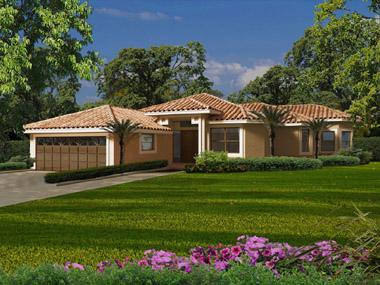
A Florida style house plan embraces the elements of many styles that allow comfort during the heat of the day.
This one story Florida-style, Mediterranean home, from Aronson & Associates is designed with three bedrooms, two and one-half bathrooms and a two-car garage. There is a huge kitchen and café opening to a family room. The luxurious master suite has a walk-in closet and regal master bath, which opens to a patio. Unique glass block around the spa tub brightens the interior of the master bathroom.
Checkout other home plans from Aronson & Associates.
Wednesday, November 25, 2009
House Plans from Aronson Architects
House plans are where the dreams begin! If you are looking at only a small selection of house plans that are available then you may never find the right house for you. Aronson Architects design and give you the selection of house plans that you crave.
Do you love looking at house plans? Some of us love to flick through magazines, dreaming about what it would be like to some day live in 'that' house.
The Internet has been a fabulous way for future homeowners to browse the sea of house plans that are available to them with simple the click of a mouse. Looking for your next dream house has never been easier!
If you do, then the Aronson Architects site is for you! Hundreds of home plans to choose from.
.... so what are you waiting for?
Do you love looking at house plans? Some of us love to flick through magazines, dreaming about what it would be like to some day live in 'that' house.
The Internet has been a fabulous way for future homeowners to browse the sea of house plans that are available to them with simple the click of a mouse. Looking for your next dream house has never been easier!
If you do, then the Aronson Architects site is for you! Hundreds of home plans to choose from.
.... so what are you waiting for?
Monday, November 23, 2009
Top 10 Luxury Homes Topping the Market
Here are the top 10 priciest properties for sale in the U.S.
1. Hala Ranch Aspen, Colo., $135 million: Owned by Prince Bandar bin Sultan bin Abdul Aziz, former Saudi Arabian ambassador to the United States, this 95-acre estate boasts a 56,000-square-foot, 15-bedroom, 16-bathroom mansion.
2. Fleur de Lys, Beverly Hills, Calif., $125 million: Suzanne Saperstein's 45,000-square-foot home is modeled after Louis XIV's palace at Versailles.
3. Maison de L'Amitie, Palm Beach, Fla., $125 million: In 2004 Donald Trump bought this property at a bankruptcy auction for $41.25 million. The refurbished version comes complete with a ballroom, conservatory, 100-foot-long ballroom, and 475 feet of ocean-front.
4. Tranquility, Lake Tahoe, Nev., $100 million: On the tax-free Nevada side of Lake Tahoe, this 210-acre property is owned by Joel Horowitz, co-founder of Tommy Hilfiger. The 20,000-square-foot main house is modeled after a northern European mountain home and has a 3,500-bottle wine cellar.
5. Three Ponds, Bridgehampton, N.Y., $75 million: This home on 60 acres features its own USGA-rated Rees Jones golf course. Surrounding the main house are 14 gardens, a 75-foot-long swimming pool, golf pro shop, grass tennis court, and a guest house.
6. The Portabello Estate, Corona del Mar, Calif., $75 million: Built in 2002, this home has eight bedrooms and 10 full baths in nearly 30,000 square feet of ultra-modern space on a triple ocean-front lot along the Pacific Ocean.
7. Malibu, Calif., $75 million: A beach home located on a flat seven-acre lot with two riding stables, a riding ring, swimming pool, tennis court, and private access to the beach.
8. The Pierre Penthouse, New York City, $70 million: This penthouse occupies the top three floors of one of the most posh hotels in New York, located on the edge of Central Park. The balconies and windows have 360-degree views of Manhattan, Central Park, the East River, and the Hudson River.
9. Belvedere, Calif., $65 million: This six-bedroom, 10,000-square-foot home offers breathtaking views of San Francisco, Angel Island, the Golden Gate Bridge, and the bay.
10. San Francisco, $65 million: This limestone mansion’s neighbors on billionaires’ row are the Getty family.
Source: Forbes.com, Matt Woolsey
1. Hala Ranch Aspen, Colo., $135 million: Owned by Prince Bandar bin Sultan bin Abdul Aziz, former Saudi Arabian ambassador to the United States, this 95-acre estate boasts a 56,000-square-foot, 15-bedroom, 16-bathroom mansion.
2. Fleur de Lys, Beverly Hills, Calif., $125 million: Suzanne Saperstein's 45,000-square-foot home is modeled after Louis XIV's palace at Versailles.
3. Maison de L'Amitie, Palm Beach, Fla., $125 million: In 2004 Donald Trump bought this property at a bankruptcy auction for $41.25 million. The refurbished version comes complete with a ballroom, conservatory, 100-foot-long ballroom, and 475 feet of ocean-front.
4. Tranquility, Lake Tahoe, Nev., $100 million: On the tax-free Nevada side of Lake Tahoe, this 210-acre property is owned by Joel Horowitz, co-founder of Tommy Hilfiger. The 20,000-square-foot main house is modeled after a northern European mountain home and has a 3,500-bottle wine cellar.
5. Three Ponds, Bridgehampton, N.Y., $75 million: This home on 60 acres features its own USGA-rated Rees Jones golf course. Surrounding the main house are 14 gardens, a 75-foot-long swimming pool, golf pro shop, grass tennis court, and a guest house.
6. The Portabello Estate, Corona del Mar, Calif., $75 million: Built in 2002, this home has eight bedrooms and 10 full baths in nearly 30,000 square feet of ultra-modern space on a triple ocean-front lot along the Pacific Ocean.
7. Malibu, Calif., $75 million: A beach home located on a flat seven-acre lot with two riding stables, a riding ring, swimming pool, tennis court, and private access to the beach.
8. The Pierre Penthouse, New York City, $70 million: This penthouse occupies the top three floors of one of the most posh hotels in New York, located on the edge of Central Park. The balconies and windows have 360-degree views of Manhattan, Central Park, the East River, and the Hudson River.
9. Belvedere, Calif., $65 million: This six-bedroom, 10,000-square-foot home offers breathtaking views of San Francisco, Angel Island, the Golden Gate Bridge, and the bay.
10. San Francisco, $65 million: This limestone mansion’s neighbors on billionaires’ row are the Getty family.
Source: Forbes.com, Matt Woolsey
Monday, November 16, 2009
Spanish style manor offers an enormous amount of living space
This Spanish style manor house plan offers an enormous amount of living space. Luxurious inside and out. Bonus room provides a cozy retreat to entertain special guests. Paneled double front doors with transom accent the covered entrance. Chef's dream Kitchen with eating bar and Cafe opens to the Family room. Luxurious Master Suite with enormous Walk-In-Closets with regal bath. Three car Garage with spacious work space. Four full bathrooms, two powder rooms and a Cabana. Three Bedrooms, Office and a library. Three Story.
Friday, November 13, 2009
Top 10 Best-Selling Consumer House Plans
These top-selling house plans speak volumes to current home buyer dreams.
By: Boyce Thompson
Builders know from sales history which of their homes buyers prefer. They can access databases to find out which of their competitors’ homes buyers prefer. But that kind of analysis only reveals what buyers may choose from what’s available.
When consumers buy house plans, like Hanley Wood’s 10 best sellers shown on the following pages, they act out a dream. They betray a longing for timeless elevations, informal living, and luxurious master suites. They dream strongly enough that they pay money to buy the plan.
Builder’s parent company, Hanley Wood, is the largest purveyor of house plans in the United States. Each year we examine their best-selling home plans to identify consumer trends. Interestingly, this year’s most popular plans, which average 3075 square feet, are a little larger than the average house plan, 2584 square feet, bought by consumers last year.
These top sellers read much bigger than they actually are. Nearly all of them feature porches, often multiple porches, typically with large windows that provide expansive views out the back of the house. These porches often read like rooms, with fireplaces, garden tubs, and more.
These top sellers are also long on first-floor, bedroom suites with sitting areas, a feature that builders may find expensive to provide in land-constrained markets. An aging population looking to avoid stairs partly explains this preference as well, along with the fact that many house plans are built in Sunbelt states. Morning kitchens and large master bathrooms were also recurring features.
10. Luxury Living on a Single Level
With its stately stone exteriors, this buttoned-down, one-story country manor would look at home in nearly any market, which may account for its popularity. An impressive, though not oversized, timber-framed entrance makes a strong first impression. It leads into a gallery flanked by a formal dining room and a great room with a window wall overlooking the rear patio. A huge master bedroom includes a sitting area and a walk-in closet that’s as large as the master bathroom. The gallery leads to a three-bedroom wing. The plan features an attached two-car garage, and a detached garage and workshop accessed through a covered breezeway.
9. Graceful Details
Here’s a classic design from Frank Betz Associates, a firm that understands the needs of production builders as well as dream home buyers. The plan packs a lot of features into 2246 square feet, including four potential bedrooms, an oversized master suite, and an optional bonus room on the second floor over the garage. The home’s otherwise geometric building footprint is punctuated by a bayed turret that houses a sunny master suite with tray ceilings and a canted bay sitting area. The plan features a vaulted great room that spills into a large, light-filled kitchen area with nook. As with many Betz plans, interior walls are kept to a minimum.
8. European Charm, American Functionality
The biggest among the top 10 best-sellers, this home would be right at home in an upscale subdivision of new California homes. A series of distinctive stone archways lead first to a garden courtyard then to the front door, with views through the back of the home. A big portion of the four-bedroom plan is devoted to family living space in the back—with a family room, kitchen, and breakfast room that function as one big space. It would be great for parties as well. If the home draws inspiration from European styles, it includes the latest American accoutrements as well--a game room, a planning center, a chef’s kitchen, and an oversized utility room.
7. Farmhouse for the Ages
There’s a timeless appeal to this 2090-square-foot farmhouse, with a porch that wraps all the way around the house. The garage almost looks like an attached barn. The classic rural elevation gives way to a modern floor plan, with a kitchen that flows into to a great room, and a large master bedroom wing complete with sitting area. A sun terrace and spa are located off the master bedroom. The formal dining room in this relatively open plan is defined by a low wall and by graceful archways set off by decorative columns. The kitchen includes a central island counter and a snack bar; it adjoins a laundry area.
6. The Eastern Shore Cottage
Who doesn’t dream of vacations enjoyed by the beach in a home like this one from legendary house plan designer William E. Poole? The Eastern Shore experience in this classic three-bedroom cottage home begins with a large screened front porch that leads to a foyer, with views through a vaulted great room to the backyard beyond. A more traditional, enclosed kitchen connects to a breakfast area that in turn opens to a great room. The plan keeps a formal dining room. The second floor features a recreation room with an additional bedroom and lots of storage space under the eaves.
5. Old World Charmer
The epicenter of this European one-story home is an imposing great room with a central fireplace on a raised stone hearth. It is flanked by a U-shaped island kitchen and a breakfast nook. The home’s old world charm extends into the master suite, which features a sitting area, built-in bookshelves, a whirlpool tub, a separate shower, a dual-sink vanity, a compartmented toilet, and a walk-in closet. Two additional family bedrooms share a full bath. A three-car garage completes the plan.
4. The Outdoor Connection
This plan accentuates connections between indoor and outdoor living. The master bedroom has private access to a small rear porch. A study connects via French doors to the front porch. Living and keeping rooms in the back of the plan both spill out to a screened rear porch. There’s even a private rear porch off the breakfast nook. The plan is ideal for a family that wants spaces to congregate and for privacy. Inside, the kitchen—equipped with plenty of counter space and storage—flows into a charming hearth-warmed keeping room with French doors. Three upstairs bedrooms have their own baths; two enjoy walk-in closets.
3. Loads of Luxury
This stately, 4376-square-foot plan features a two-story foyer, a columned dining room, and a personal library complete with built-in desks. The main-level master suite is the real showstopper: it includes an L-shaped walk-in closet, a garden tub, a sitting area, and a morning kitchen. Three family bedrooms upstairs each have a full bath and ample closet space. In addition to the bedrooms, the option of a game room/billiards room provides plenty of space for casual entertainment. A three-car garage completes this plan.
2. Big Value Proposition
This classic one-story, great-room plan from Don Gardner packs a ton of living space into a mere 2097 square feet. A Craftsman elevation with stone and wood siding provides rustic curb appeal. The home features an impressive view from the front door, through a vaulted great room, to a screened porch in the rear. Cathedral ceilings grace the great room, breakfast room, and study. Interior columns announce the great room, with a fireplace and surrounding built-ins. Two bedrooms share a full bath. The master bedroom includes two, full walk-in closets. The plan includes a breakfast nook, a study that could also serve as a fourth bedroom, and a formal dining room.
1. Outdoor Living to the Max
With numerous sprawling porches, an outdoor fireplace, and a breezeway, this 3126-square-foot, one-story home is all about outdoor living. The open floor plan with wrapping porches provides many opportunities to enjoy calming views. Off the back of the house, a large covered porch with an outdoor fireplace provides a comfortable way to enjoy the outdoors. An open and airy kitchen leads onto a screened porch. Picture windows, a light-infused breakfast nook, and a vaulted lodge room continue the pastoral theme throughout the interior. The house features a vaulted foyer and dramatic dining room, which leads into the lodge room, complete with a stone fireplace and a vaulted ceiling.
From: BUILDER 2009
By: Boyce Thompson
Builders know from sales history which of their homes buyers prefer. They can access databases to find out which of their competitors’ homes buyers prefer. But that kind of analysis only reveals what buyers may choose from what’s available.
When consumers buy house plans, like Hanley Wood’s 10 best sellers shown on the following pages, they act out a dream. They betray a longing for timeless elevations, informal living, and luxurious master suites. They dream strongly enough that they pay money to buy the plan.
Builder’s parent company, Hanley Wood, is the largest purveyor of house plans in the United States. Each year we examine their best-selling home plans to identify consumer trends. Interestingly, this year’s most popular plans, which average 3075 square feet, are a little larger than the average house plan, 2584 square feet, bought by consumers last year.
These top sellers read much bigger than they actually are. Nearly all of them feature porches, often multiple porches, typically with large windows that provide expansive views out the back of the house. These porches often read like rooms, with fireplaces, garden tubs, and more.
These top sellers are also long on first-floor, bedroom suites with sitting areas, a feature that builders may find expensive to provide in land-constrained markets. An aging population looking to avoid stairs partly explains this preference as well, along with the fact that many house plans are built in Sunbelt states. Morning kitchens and large master bathrooms were also recurring features.
10. Luxury Living on a Single Level
With its stately stone exteriors, this buttoned-down, one-story country manor would look at home in nearly any market, which may account for its popularity. An impressive, though not oversized, timber-framed entrance makes a strong first impression. It leads into a gallery flanked by a formal dining room and a great room with a window wall overlooking the rear patio. A huge master bedroom includes a sitting area and a walk-in closet that’s as large as the master bathroom. The gallery leads to a three-bedroom wing. The plan features an attached two-car garage, and a detached garage and workshop accessed through a covered breezeway.
9. Graceful Details
Here’s a classic design from Frank Betz Associates, a firm that understands the needs of production builders as well as dream home buyers. The plan packs a lot of features into 2246 square feet, including four potential bedrooms, an oversized master suite, and an optional bonus room on the second floor over the garage. The home’s otherwise geometric building footprint is punctuated by a bayed turret that houses a sunny master suite with tray ceilings and a canted bay sitting area. The plan features a vaulted great room that spills into a large, light-filled kitchen area with nook. As with many Betz plans, interior walls are kept to a minimum.
8. European Charm, American Functionality
The biggest among the top 10 best-sellers, this home would be right at home in an upscale subdivision of new California homes. A series of distinctive stone archways lead first to a garden courtyard then to the front door, with views through the back of the home. A big portion of the four-bedroom plan is devoted to family living space in the back—with a family room, kitchen, and breakfast room that function as one big space. It would be great for parties as well. If the home draws inspiration from European styles, it includes the latest American accoutrements as well--a game room, a planning center, a chef’s kitchen, and an oversized utility room.
7. Farmhouse for the Ages
There’s a timeless appeal to this 2090-square-foot farmhouse, with a porch that wraps all the way around the house. The garage almost looks like an attached barn. The classic rural elevation gives way to a modern floor plan, with a kitchen that flows into to a great room, and a large master bedroom wing complete with sitting area. A sun terrace and spa are located off the master bedroom. The formal dining room in this relatively open plan is defined by a low wall and by graceful archways set off by decorative columns. The kitchen includes a central island counter and a snack bar; it adjoins a laundry area.
6. The Eastern Shore Cottage
Who doesn’t dream of vacations enjoyed by the beach in a home like this one from legendary house plan designer William E. Poole? The Eastern Shore experience in this classic three-bedroom cottage home begins with a large screened front porch that leads to a foyer, with views through a vaulted great room to the backyard beyond. A more traditional, enclosed kitchen connects to a breakfast area that in turn opens to a great room. The plan keeps a formal dining room. The second floor features a recreation room with an additional bedroom and lots of storage space under the eaves.
5. Old World Charmer
The epicenter of this European one-story home is an imposing great room with a central fireplace on a raised stone hearth. It is flanked by a U-shaped island kitchen and a breakfast nook. The home’s old world charm extends into the master suite, which features a sitting area, built-in bookshelves, a whirlpool tub, a separate shower, a dual-sink vanity, a compartmented toilet, and a walk-in closet. Two additional family bedrooms share a full bath. A three-car garage completes the plan.
4. The Outdoor Connection
This plan accentuates connections between indoor and outdoor living. The master bedroom has private access to a small rear porch. A study connects via French doors to the front porch. Living and keeping rooms in the back of the plan both spill out to a screened rear porch. There’s even a private rear porch off the breakfast nook. The plan is ideal for a family that wants spaces to congregate and for privacy. Inside, the kitchen—equipped with plenty of counter space and storage—flows into a charming hearth-warmed keeping room with French doors. Three upstairs bedrooms have their own baths; two enjoy walk-in closets.
3. Loads of Luxury
This stately, 4376-square-foot plan features a two-story foyer, a columned dining room, and a personal library complete with built-in desks. The main-level master suite is the real showstopper: it includes an L-shaped walk-in closet, a garden tub, a sitting area, and a morning kitchen. Three family bedrooms upstairs each have a full bath and ample closet space. In addition to the bedrooms, the option of a game room/billiards room provides plenty of space for casual entertainment. A three-car garage completes this plan.
2. Big Value Proposition
This classic one-story, great-room plan from Don Gardner packs a ton of living space into a mere 2097 square feet. A Craftsman elevation with stone and wood siding provides rustic curb appeal. The home features an impressive view from the front door, through a vaulted great room, to a screened porch in the rear. Cathedral ceilings grace the great room, breakfast room, and study. Interior columns announce the great room, with a fireplace and surrounding built-ins. Two bedrooms share a full bath. The master bedroom includes two, full walk-in closets. The plan includes a breakfast nook, a study that could also serve as a fourth bedroom, and a formal dining room.
1. Outdoor Living to the Max
With numerous sprawling porches, an outdoor fireplace, and a breezeway, this 3126-square-foot, one-story home is all about outdoor living. The open floor plan with wrapping porches provides many opportunities to enjoy calming views. Off the back of the house, a large covered porch with an outdoor fireplace provides a comfortable way to enjoy the outdoors. An open and airy kitchen leads onto a screened porch. Picture windows, a light-infused breakfast nook, and a vaulted lodge room continue the pastoral theme throughout the interior. The house features a vaulted foyer and dramatic dining room, which leads into the lodge room, complete with a stone fireplace and a vaulted ceiling.
From: BUILDER 2009
Tuesday, November 10, 2009
Florida Builders Generate Sales With Perfect Balance of Price and Product
Stock Development has found surprisingly safe “passage” through Fort Myers, Fla., which during the recession has held the dubious distinction of being one of the worst housing markets in the United States.
“We’re not making a ton of margin at Paseo, but we are selling product,” says Wetzel. Stock has released several models for Phase II of Paseo, where it plans to build 172 units.
At River Sound, Neal has a lender on site to prequalify borrowers. “We’re seeing a lot of people who are willing to buy to-be-builts as opposed to specs, which we see as a positive sign,” says Weintraub.
Stock, a developer and builder based in Naples, Fla., through early April had sold 259 of its 279 flats, townhouses, casitas, and single-family homes in the first phase of Paseo (which means “passage” in Spanish), its stylish neighborhood located in South Fort Myers. Since the beginning of this year more than 2,000 prospects have visited Paseo, and in the past 15 months alone Stock has sold more than 140 units there, according to Tim Clark, the community’s vice president of sales.
Claudine Leger-Wetzel, Stock’s vice president of sales and marketing, attributes Paseo’s success to her company’s philosophy “to continuously market and brand itself and its products.” At a time when other builders were tripping over each other to get out of Fort Myers, Stock Development was offering “a very lifestyle-oriented” community with all of its amenities delivered, including a 5,000-square-foot fitness center, pool, and restaurants.
Wetzel says Paseo, whose first phase features 18 model homes, has been drawing between 125 and 150 registered prospects per week. Stock stoked interest in this community by hosting a Parade of Homes there, as well as monthly music festivals (which it does at its two other communities as well.) Paseo also offers breathtaking vistas of nearly lakes and the Six Mile Cypress Slough.
But Paseo’s main attraction, Wetzel freely admits, is the community’s “aggressive” pricing: Prices for flats and townhomes, which range from 1,227 square feet to 2,084 square feet, start at $169,000. The neighborhood offers two-story and courtyard-style single family homes as large as 3,000 square feet. One such house—its Montessa model, at 2,293 square feet with three bathrooms—fetched $444,990 in a recent sale.
Further evidence that Florida’s housing market is coming out of its coma are found at Neal Communities, a Lakewood Ranch, Fla.-based developer and builder that, through the first three months of this year, sold 109 homes, its best quarter in three years, confirms Leisa Weintraub, its vice president of marketing.
“We’ve definitely seen an uptick,” Weintraub tells BUILDER, which she attributes to several factors. First and foremost, “the prices are right.” Its 182-unit River Sound, a gated community with lots of amenities in Bradenton, Fla., that Neal opened on February 21, has made hay with a series of detached two- and three-bedroom cottages—ranging from 947 square feet to 1,648 square feet, alley loaded, and 20-feet wide on 27-foot-wide lots—that start at $109,600. “That [price] brought a lot of people in the door,” says Weintraub, a good number of whom were first-time buyers who didn’t have to worry about selling their existing houses.
Neal Communities promoted River Sound with the tagline: “Everyone’s talking about change. We’re doing it.” It also did a lot of public relations, including a press conference that local dignitaries attended and three TV stations covered. The company reached out to local realtors, who are a focus of Neal’s marketing strategy. (Weintraub says that nearly half of the company’s sales this year have been through real estate agents, which is actually low by historical measures because there have been so many walk-ins at River Sound.)
Both Stock and Neal are optimistic about their future growth, based on the activity they’re seeing at other communities.
Through mid April Stock has sold more houses at Vivante, its waterfront community in Punta Gordo, Fla., than it did in that community all of last year. The listed prices for homes there range from $149,900 to $400,000, and have been “heavily discounted,” says Weintraub, who notes that the vast majority of buyers are paying in cash. Stock’s largest community—the 3,000-acre Lely Resort in Naples—sold 50 homes in March alone, at prices ranging from $180,000 to $1 million.
Neal is currently selling from 10 communities that include country-club and golf-course neighborhoods. It is currently building an 800-unit community, to be called Central Park, which Weintraub says should be ready for sale in early 2011.
John Caulfield is senior editor at BUILDER magazine.
Friday, October 23, 2009
Valrico Builder Chuck Fowke to Become Florida Home Builders Association President
TALLAHASSEE – Valrico home builder John “Chuck” Fowke is slated to become the President of the Florida Home Builders Association (FHBA) this Friday, October 30 during a ceremony at the Renaissance Vinoy Resort in St. Petersburg. Fowke, who will assume the role from Punta Gorda builder Jay Carlson, will serve as President of FHBA’s 10,000-plus members for a one-year term.
Joining Fowke in leading FHBA members will be Tampa-area land use attorney Judy James. James will serve as FHBA’s Second Vice President – the highest ranking leadership position for an associate member.
FHBA is a Tallahassee-based trade association involved in Florida’s home building, commercial construction and remodeling industry. Known as the voice of Florida’s housing industry, FHBA has 27 local home builders associations throughout Florida, including the Tampa Bay Builders Association where both Fowke and James are members.
Fowke, the founder of Homes by John C. Fowke, is a leading Suncoast luxury home builder. He launched his career in the Tampa area in 1974 – more than 30 years ago – after a stint as a professional baseball player with the Texas Rangers.
James, a graduate of the University of Florida Law School, began her law firm in 1983. She is a longtime advocate for sensible growth, and is widely respected for her land use and permitting expertise.
Fowke and James will be installed as President and Second Vice President on Friday during a banquet being held in conjunction with FHBA’s Fall Leadership Conference.
About FHBA: The Florida Home Builders Association is a Tallahassee, Florida-based trade association representing more than 10,000 corporate members involved in Florida’s home building, remodeling and commercial construction industry. Known as “the voice of Florida’s housing industry,” FHBA is affiliated with 27 local home builders associations throughout Florida. Its subsidiaries include Florida Home Builders Insurance, Inc., which provides risk management and insurance services to members. FHBA was founded in 1949 as the state affiliate of the National Association of Home Builders. Visit us on the web at www.fhba.com.
Joining Fowke in leading FHBA members will be Tampa-area land use attorney Judy James. James will serve as FHBA’s Second Vice President – the highest ranking leadership position for an associate member.
FHBA is a Tallahassee-based trade association involved in Florida’s home building, commercial construction and remodeling industry. Known as the voice of Florida’s housing industry, FHBA has 27 local home builders associations throughout Florida, including the Tampa Bay Builders Association where both Fowke and James are members.
Fowke, the founder of Homes by John C. Fowke, is a leading Suncoast luxury home builder. He launched his career in the Tampa area in 1974 – more than 30 years ago – after a stint as a professional baseball player with the Texas Rangers.
James, a graduate of the University of Florida Law School, began her law firm in 1983. She is a longtime advocate for sensible growth, and is widely respected for her land use and permitting expertise.
Fowke and James will be installed as President and Second Vice President on Friday during a banquet being held in conjunction with FHBA’s Fall Leadership Conference.
About FHBA: The Florida Home Builders Association is a Tallahassee, Florida-based trade association representing more than 10,000 corporate members involved in Florida’s home building, remodeling and commercial construction industry. Known as “the voice of Florida’s housing industry,” FHBA is affiliated with 27 local home builders associations throughout Florida. Its subsidiaries include Florida Home Builders Insurance, Inc., which provides risk management and insurance services to members. FHBA was founded in 1949 as the state affiliate of the National Association of Home Builders. Visit us on the web at www.fhba.com.
Tuesday, October 13, 2009
Dream home's design based on floor plans and imagination -- baltimoresun.com
By Marie Gullard
These are big houses on tiny lots," Eileen Jacobs says of her two-story, all-brick traditional home in Owings Mills.
Her decorating challenge, therefore, was not the exterior but rather the interior space of 3,400 square feet, not counting the basement. She was more than up to the task, and while the house was being constructed, she designed rooms and bought furnishings working only from floor plans.
"The [design] was all in my mind's eye before we moved," she said. "One to two months afterward, I had everything in place."
Eileen Jacobs, a dental hygienist, and her husband, Howard Jacobs, a pulmonologist, settled in their $750,000 home in May 2008. An additional $58,000 was spent on interior upgrades (such as a floor-to-ceiling, double-sided stone fireplace in the family room), furniture and accessories, and a screen-enclosed outdoor deck.
Eileen Jacobs worked from a self-designated color palette of warm shades embracing beige, brown and orange throughout the open layout of the home's first floor, complete with master suite. Here, she says, she and her husband can live comfortably without ever having to use the second level.
Included on the first level are a large living room and dining room on either side of an entrance hall, an open kitchen, study, powder room, a grand family room that's open to the second level, a cheerful sunroom, master bedroom with bath and a screened porch.
The open kitchen at the rear of the home boasts 42-inch walnut cabinets with warm granite counters complementing a rustic backsplash of travertine tile.
An inlaid mahogany pedestal table is graced with place mats woven in autumn shades of yellow, red and brown. Oak flooring (found throughout the first level) and walls painted in a rich shade of burnt sienna, complete the cozy and welcoming design.
"My favorite room is the family room," Eileen Jacobs said.
Once again, warmth owns the space here in walls painted medium beige with an accent wall displaying a stenciled, bold flower design in brown and white. Supple brown leather furniture is softened by the presence of accent chairs in white duck cloth, and personalized with a framed painting of the Jacobs' two grown sons, Danny and Mitchell.
The screened-in porch is Howard Jacobs' favorite place to be. Here, wrought-iron furniture with plump cushioned chairs cozy up to a wide-screen TV.
Eileen Jacobs' designs for her four-bedroom second level are still in the planning stage. There is no rush for this self-proclaimed budget-conscious, maintenance-free designer who admits she doesn't like fuss.
"We're not going anywhere," she said. "I'm tired of moving."
Have you found your dream home? Tell us about it at homes@baltsun.com.
Dream element: The Jacobs' two-story home sits opposite a large estate in Owings Mills. When the estate's owner sold off a hefty parcel of the land, developers Richmond American planned the construction of 21 homes on the property. The Jacobs' all brick, traditional-style home was the first one completed and has the enviable position across from the original manor house.
Design inspiration: Eileen Jacobs decorated her home in traditional fashion on what she proudly calls a budget. "I bought everything before the house was even built," she said. And while choosing many construction upgrades that include a two-sided fireplace in the great room, a first-level master bedroom, granite counters and Berber carpeting, she then proceeded to shop discount stores such as Home Goods, Marshall's and Target for each room's accessories. She purchased her furniture, of which 75 percent is new, from Gardiner's and Home Goods.
Surprise feature: In Eileen Jacob's living and dining rooms, she takes an artistic twist on the current trend of painting an accent wall in vertical strips of coordinating colors. Instead, her wide stripes of taupe and medium beige are horizontal, and in the dining room this technique is used only to the chair rail where the bottom half of the wall is paneled and inlaid with boxes of grass cloth.
Personal touch: Eileen Jacobs, who never once sought the help of an interior decorator, says, "You need to have a good eye and know where things go." She is keen on putting unlikely items together, such as formal curtain tassels draped over hanging bath towels and beads cascading down a window on her staircase landing for some coverage, but mostly light. She notes that several of her ideas have come from watching HGTV.
These are big houses on tiny lots," Eileen Jacobs says of her two-story, all-brick traditional home in Owings Mills.
Her decorating challenge, therefore, was not the exterior but rather the interior space of 3,400 square feet, not counting the basement. She was more than up to the task, and while the house was being constructed, she designed rooms and bought furnishings working only from floor plans.
"The [design] was all in my mind's eye before we moved," she said. "One to two months afterward, I had everything in place."
Eileen Jacobs, a dental hygienist, and her husband, Howard Jacobs, a pulmonologist, settled in their $750,000 home in May 2008. An additional $58,000 was spent on interior upgrades (such as a floor-to-ceiling, double-sided stone fireplace in the family room), furniture and accessories, and a screen-enclosed outdoor deck.
Eileen Jacobs worked from a self-designated color palette of warm shades embracing beige, brown and orange throughout the open layout of the home's first floor, complete with master suite. Here, she says, she and her husband can live comfortably without ever having to use the second level.
Included on the first level are a large living room and dining room on either side of an entrance hall, an open kitchen, study, powder room, a grand family room that's open to the second level, a cheerful sunroom, master bedroom with bath and a screened porch.
The open kitchen at the rear of the home boasts 42-inch walnut cabinets with warm granite counters complementing a rustic backsplash of travertine tile.
An inlaid mahogany pedestal table is graced with place mats woven in autumn shades of yellow, red and brown. Oak flooring (found throughout the first level) and walls painted in a rich shade of burnt sienna, complete the cozy and welcoming design.
"My favorite room is the family room," Eileen Jacobs said.
Once again, warmth owns the space here in walls painted medium beige with an accent wall displaying a stenciled, bold flower design in brown and white. Supple brown leather furniture is softened by the presence of accent chairs in white duck cloth, and personalized with a framed painting of the Jacobs' two grown sons, Danny and Mitchell.
The screened-in porch is Howard Jacobs' favorite place to be. Here, wrought-iron furniture with plump cushioned chairs cozy up to a wide-screen TV.
Eileen Jacobs' designs for her four-bedroom second level are still in the planning stage. There is no rush for this self-proclaimed budget-conscious, maintenance-free designer who admits she doesn't like fuss.
"We're not going anywhere," she said. "I'm tired of moving."
Have you found your dream home? Tell us about it at homes@baltsun.com.
Making a dream home
Dream element: The Jacobs' two-story home sits opposite a large estate in Owings Mills. When the estate's owner sold off a hefty parcel of the land, developers Richmond American planned the construction of 21 homes on the property. The Jacobs' all brick, traditional-style home was the first one completed and has the enviable position across from the original manor house.
Design inspiration: Eileen Jacobs decorated her home in traditional fashion on what she proudly calls a budget. "I bought everything before the house was even built," she said. And while choosing many construction upgrades that include a two-sided fireplace in the great room, a first-level master bedroom, granite counters and Berber carpeting, she then proceeded to shop discount stores such as Home Goods, Marshall's and Target for each room's accessories. She purchased her furniture, of which 75 percent is new, from Gardiner's and Home Goods.
Surprise feature: In Eileen Jacob's living and dining rooms, she takes an artistic twist on the current trend of painting an accent wall in vertical strips of coordinating colors. Instead, her wide stripes of taupe and medium beige are horizontal, and in the dining room this technique is used only to the chair rail where the bottom half of the wall is paneled and inlaid with boxes of grass cloth.
Personal touch: Eileen Jacobs, who never once sought the help of an interior decorator, says, "You need to have a good eye and know where things go." She is keen on putting unlikely items together, such as formal curtain tassels draped over hanging bath towels and beads cascading down a window on her staircase landing for some coverage, but mostly light. She notes that several of her ideas have come from watching HGTV.
Copyright © 2009, The Baltimore Sun
Thursday, October 8, 2009
How Computers Have Changed the Way of Designing Homes
Introduction
The Real Estate Industry is one of the industry where computers and computer aided design (CAD) is changing the way we design houses.
In the earlier days the use of CAD in the real estate industry was limited to only a handful of tech savvy people and those companies who had a technical person as their staff. This person was highly skilled and used to prepare construction documents using CAD programs such as AutoCAD. 3D modeling was used but only occasionally.
The home design industry is witnessing a see change. With the advancement of the CAD software which has now become very user friendly, it is gradually recieving wide acceptence.
Virtual Construction of the Home
With the help of the new improved version of CAD tool a virtual three-dimensional model is being created that contains very useful tool which can be used not only for visualization of the house but also for manufacturing purposes.
This technology enables one to visualize and walk through the home in 3D, giving minute details of how the home will appear even before the start of the construction process. The advantage here is that the homeowner gets a clear understanding of how the home is going to look like after completion leaving no scope of misunderstanding.Moreover, modern technology allows 3D building models to carry with it behavior, rather than just the appearance of the element. Software developers now give their objects relationships with each other. An example of this would be the moving of a window in a framed wall which causes the stud framing to update and re-apply itself, using a defined set of rules that associate spacing and sizing options.
Technology for the consumer retail market
Purchasing a high-end CAD system is not required. Instead one can utilize object-oriented technology in the building industry. Discuss the matter with your local business supply or stationary store and you may end up finding 10 different examples of "design your own home" or "landscaping" software.
A best-known example is 3D Home Design Suite by Broderbund and is one of the leading publishers of home and landscape design. This program enables the user to quickly and quite easily design his/her own home, virtually including the interior and create a photo-realistic rendering in minutes. This design can then be exported via DXF to AutoCAD or other CAD packages for the creation of professional working drawings.These user friendly packages enables even a novice person create a sellable designs that may almost be compared to those found in real-estate sales offices.
CAD Technology used in Residential Sales Offices.
The Real Estate Industry revolves around the sale of the home and in the earlier days model homes or expensive artist's renderings had to be created.Models and digital renderings are now quickly replaced by images created with the help of software packages like CAD.It also enables the businesses to clearly communicate the business messege to their client.
Technology for the Manufactured Home Industry
The manufactured home industry may be segregated under three catagories: Modular, Panelized and HUD. Computer technology can no doubt benefit this industry more than any other because of the large degree of automation available. These types of manufactures now have the ability to attach large amounts of data to their model homes ranging from the exact cut lists and wall panel diagram information, to a complete bill of materials that link to a purchase ordering system and estimating package.
KML Homes in Cambridge, Ontario, Canada, is one of the best example of new age manufacturing plant that now a dayy are using design software to automate their panelized process. Focussing on a light-gauge steel framing system, they currently receive custom plans from Architects electronically (usually in AutoCAD format) and convert them to create a 3D AutoCAD model using a third party add-on product. Once the model is created, KML can now completely frame the walls, floors and roofs and divide them into an efficient panelizing system. This panel data is then electronically transferred to the production floor, where the panels are assembled and shipped to site where they are assembled onto a waiting foundation.
KML estimates that within the past eight months, they have increased productivity by 100% and future implementation will increase that by another 60%.
Conclusion
From the above discussion we get a clear understanding of how computers have changed, and are continuing to change the way we design houses, ranging from the consumer retail market, real-estate offices, to the manufactured home industry.
The Real Estate Industry is one of the industry where computers and computer aided design (CAD) is changing the way we design houses.
In the earlier days the use of CAD in the real estate industry was limited to only a handful of tech savvy people and those companies who had a technical person as their staff. This person was highly skilled and used to prepare construction documents using CAD programs such as AutoCAD. 3D modeling was used but only occasionally.
The home design industry is witnessing a see change. With the advancement of the CAD software which has now become very user friendly, it is gradually recieving wide acceptence.
Virtual Construction of the Home
With the help of the new improved version of CAD tool a virtual three-dimensional model is being created that contains very useful tool which can be used not only for visualization of the house but also for manufacturing purposes.
This technology enables one to visualize and walk through the home in 3D, giving minute details of how the home will appear even before the start of the construction process. The advantage here is that the homeowner gets a clear understanding of how the home is going to look like after completion leaving no scope of misunderstanding.Moreover, modern technology allows 3D building models to carry with it behavior, rather than just the appearance of the element. Software developers now give their objects relationships with each other. An example of this would be the moving of a window in a framed wall which causes the stud framing to update and re-apply itself, using a defined set of rules that associate spacing and sizing options.
Technology for the consumer retail market
Purchasing a high-end CAD system is not required. Instead one can utilize object-oriented technology in the building industry. Discuss the matter with your local business supply or stationary store and you may end up finding 10 different examples of "design your own home" or "landscaping" software.
A best-known example is 3D Home Design Suite by Broderbund and is one of the leading publishers of home and landscape design. This program enables the user to quickly and quite easily design his/her own home, virtually including the interior and create a photo-realistic rendering in minutes. This design can then be exported via DXF to AutoCAD or other CAD packages for the creation of professional working drawings.These user friendly packages enables even a novice person create a sellable designs that may almost be compared to those found in real-estate sales offices.
CAD Technology used in Residential Sales Offices.
The Real Estate Industry revolves around the sale of the home and in the earlier days model homes or expensive artist's renderings had to be created.Models and digital renderings are now quickly replaced by images created with the help of software packages like CAD.It also enables the businesses to clearly communicate the business messege to their client.
Technology for the Manufactured Home Industry
The manufactured home industry may be segregated under three catagories: Modular, Panelized and HUD. Computer technology can no doubt benefit this industry more than any other because of the large degree of automation available. These types of manufactures now have the ability to attach large amounts of data to their model homes ranging from the exact cut lists and wall panel diagram information, to a complete bill of materials that link to a purchase ordering system and estimating package.
KML Homes in Cambridge, Ontario, Canada, is one of the best example of new age manufacturing plant that now a dayy are using design software to automate their panelized process. Focussing on a light-gauge steel framing system, they currently receive custom plans from Architects electronically (usually in AutoCAD format) and convert them to create a 3D AutoCAD model using a third party add-on product. Once the model is created, KML can now completely frame the walls, floors and roofs and divide them into an efficient panelizing system. This panel data is then electronically transferred to the production floor, where the panels are assembled and shipped to site where they are assembled onto a waiting foundation.
KML estimates that within the past eight months, they have increased productivity by 100% and future implementation will increase that by another 60%.
Conclusion
From the above discussion we get a clear understanding of how computers have changed, and are continuing to change the way we design houses, ranging from the consumer retail market, real-estate offices, to the manufactured home industry.
